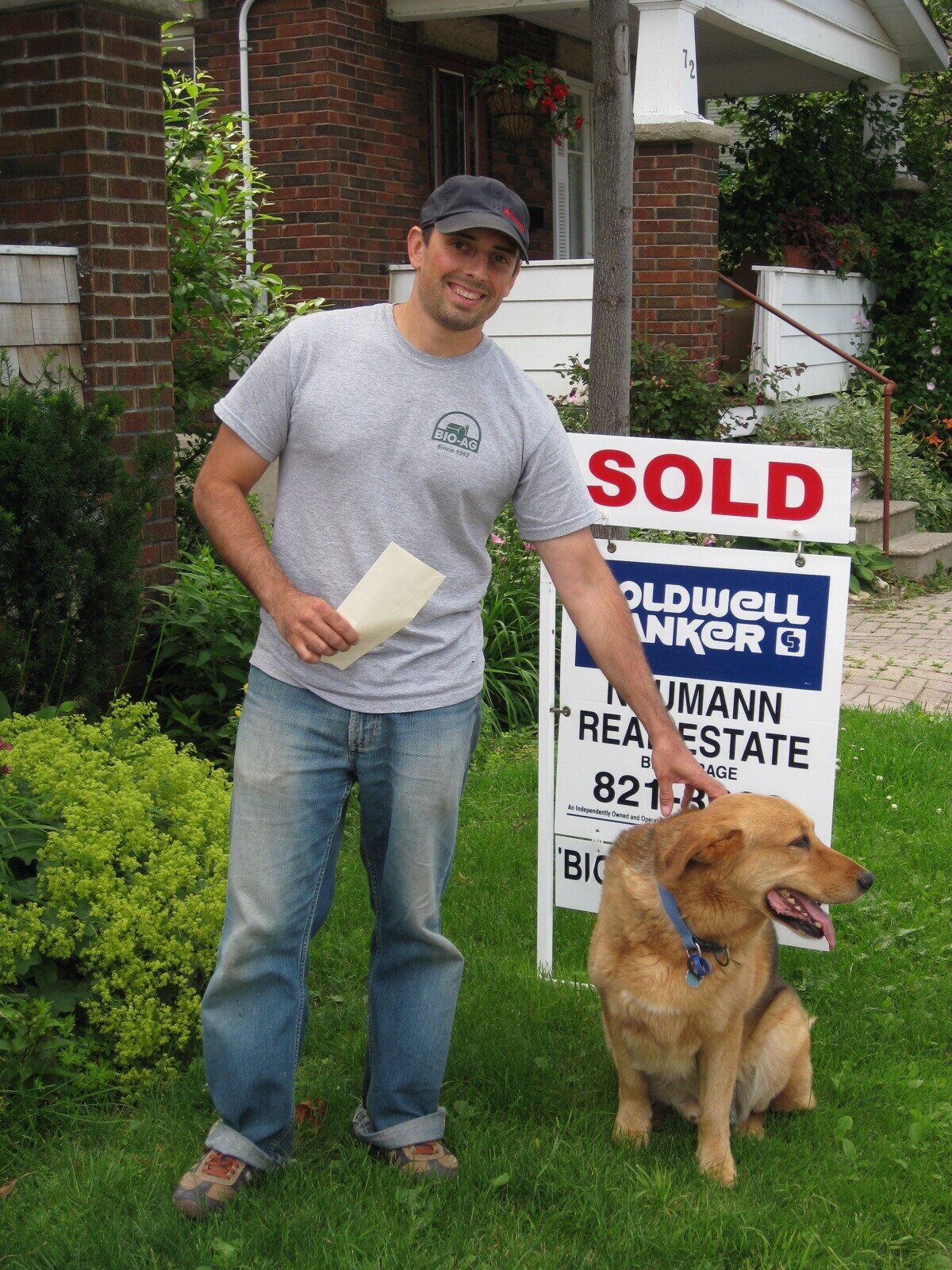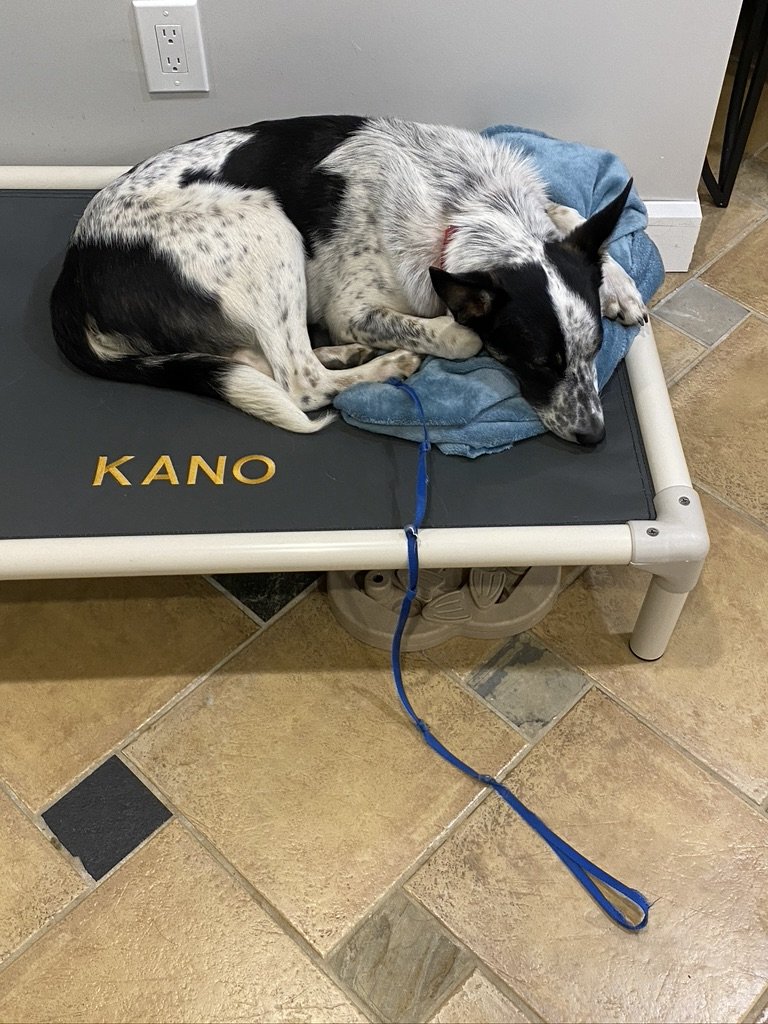Welcome to The Calmness Club™ (Photo: A shaggy black dog relaxing on his owner’s outstretched legs.)
Forget everything you know about old school dog training class where you’re surrounded by other dogs lunging on leash and barking. No. That was never for you.
You crave calmness and you want your dog to be calm too. This is the opportunity you’ve been waiting for.
Welcome to The Calmness Club™ — a special place to practice calmness with your dog.
Our location is spacious with lots of natural light and filled with plants. What better place to relax and foster a calm state of mind?
You’ve been working on the place command and loose leash walking and it’s going pretty well, but you’re still struggling to achieve calmness on leash and on place in new settings, like when you visit your family and there’s other dogs present who have no off-switch or when you’re at your cottage and there’s lots of wildlife distractions.
This is your chance to practice calmness and neutrality around other dogs and owners who have the same goals as you.
This is a unique opportunity being offered to owners who are out there working hard with their dogs every single day.
Get ready to love your Thursday mornings. Sip your tea. Wear your comfy clothes. And definitely don’t do your hair.
Happy, smiling woman presents a tug toy for a German Shepherd mix while sitting on a gym floor.
The Calmness Club was created for you.
You want your dog to be able to relax inside your home, on your porch or balcony, and in your backyard. You would also love it if she could chill when you’re at the cottage, on vacation (hotel, Air BnB, parent’s house, etc,) or while hanging out at a park or local patio.
It takes practice to achieve a calm state of mind in all of these places, so we created The Calmness Club — a place for you and your dog to practice lifestyle skills and relaxation — together!
Whether you want your dog to be calm on a patio or at your kid’s soccer games, you need to develop and practice your calmness skills around other like-minded owners. (Photo: Golden Retriever puppy relaxing on a restaurant patio.)
Here’s what Calmness Club members are saying about The Calmness Club:
““It was a great experience for us and our dog.”
”
““Looking forward to next week!”
”
Other amazing benefits?
-Our space also has a long elevated table with chairs — can you say “what a great place to practice calmness at patios and restaurants?” I sure can!
-The room has movable partitions, so if you need to carve out a little space for yourself and your pup, you can.
-Dreamland Pet is right next door, so if you need anything for your pets you can shop in a relaxing environment after enjoying your time at The Calmness Club.
We also have access to a large, quiet parking lot to practice calm car exits and loose leash walking. There’s a long and narrow stretch of grass for potty breaks which can also be used as a distraction if your loose leash walking skills are advanced.
Here’s what Calmness Club members have to say about our training space:
“I’m in love with this room. There’s so much light. It’s the nicest training space we’ve ever been to.”
Here’s the details:
Location: Dreamland Pet in Elora
Dates: Thursday April 11th, 2024 kicks off 4 consecutive weeks of calmness: (April 11, April 18, April 25, and May 2nd.)
Time: 10:00 AM - 11:00 AM
Register now and you’ll receive a 10% early bird discount. Click the link to register. I'm an early bird!
Hurry. This early bird pricing will only be in effect until midnight on March 24th.
Early bird price: $225 + HST
After the early bird sale is over, the cost will be $250 + HST, so what are you waiting for? Sign up now. Spots are limited to set everyone up for success.
THERE’S ONLY THREE SPOTS LEFT IN THE CALMNESS CLUB. REGISTER NOW TO SECURE YOUR SPOT IN: The Calmness Club
It’s your time to build a beautiful relationship with your dog built on calmness and trust.
What do you want your life with your dog to look like? (Photo: A woman wearing a toque reaches down to pet her dog while enjoying a beautiful view of a lake at the top of a cliff.)
One more perk?
This space used to be a gym, so if your goal is to be able to work out at home and not have your dog ruin your workout by stealing (or chewing up) your yoga mat, bring it along so you can practice the lifestyle you want. Or maybe you’ve always wanted to try meditation and you’d like to sit calmly on the ground and have your dog stay on place. Whatever your calmness goals are, this is the place you’re going to achieve them. This is real life dog training. The place where dog training becomes a part of your lifestyle and starts to feels easy.
You’re ready to be surrounded by like-minded dog leaders to keep advancing your skills. Use this direct link to grab your spot right now: Yes! This is what I've been waiting for!
Whatever your lifestyle goals are for yourself and your dog, The Calmness Club is the place to achieve them. (Photo: woman doing yoga outdoors beside an Australian Shepherd.)
This club is going to bring much needed calmness into your life and your dog’s life.
Imagine the possibilities life holds once you practice calmness in this setting. Envision yourself being able to do yoga in your living room, without the drama of your dog stealing your mat (or chewing it to bits.) Picture yourself being able to sit and meditate beside your dog’s cot, both of you in a totally relaxed state. Visualize sipping your favourite beverage out on the patio this season with your dog relaxing at your feet. Imagine hiking with your dog on a trail and finally feeling calm.
Dream big and bring those dreams to Dreamland for The Calmness Club.
Dream big and bring those dreams to The Calmness Club (Photo: silhouette of a person facing their dog with a sunset in the background.)
I can’t wait to watch your calmness skills flourish.
Yours in calmness,
Alyssa
Photos by: Graham Smith @smithographic (shaggy black dog relaxing on his owner’s outstretched legs,) LOGAN WEAVER | @LGNWVR @lgnwvr (happy, smiling woman presents a tug toy for a German Shepherd mix,) Anders Ipsen @andersipsen (Golden Retriever puppy relaxing on a restaurant patio,)Coral Ouellette
@coralouellette (A woman wearing a toque reaches down to pet her dog while enjoying a beautiful view of a lake at the top of a cliff,) Alonso Reyes @alonsoreyes (woman doing yoga outdoors beside an Australian Shepherd,) Patrick Hendry @worldsbetweenlines (silhouette of a person facing their dog with a sunset in the background.)


























































